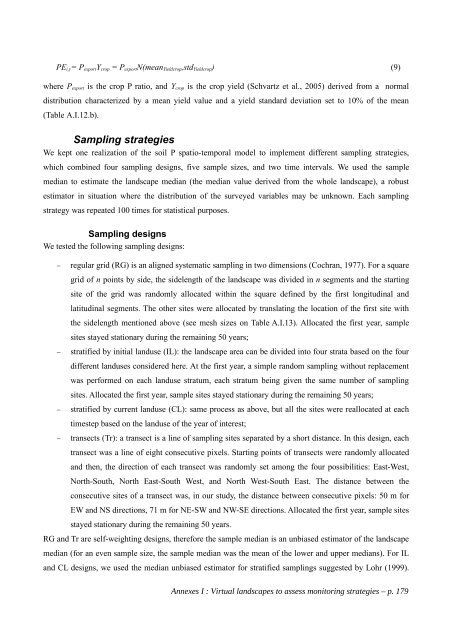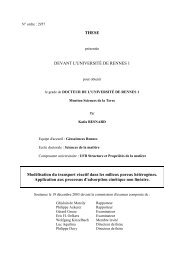Paysages virtuels et analyse de scénarios pour évaluer les impacts ...
Paysages virtuels et analyse de scénarios pour évaluer les impacts ...
Paysages virtuels et analyse de scénarios pour évaluer les impacts ...
Create successful ePaper yourself
Turn your PDF publications into a flip-book with our unique Google optimized e-Paper software.
PEi,y= PexportYcrop = PexportN(meanYieldcrop,stdYieldcrop) (9)<br />
where Pexport is the crop P ratio, and Ycrop is the crop yield (Schvartz <strong>et</strong> al., 2005) <strong>de</strong>rived from a normal<br />
distribution characterized by a mean yield value and a yield standard <strong>de</strong>viation s<strong>et</strong> to 10% of the mean<br />
(Table A.I.12.b).<br />
Sampling strategies<br />
We kept one realization of the soil P spatio-temporal mo<strong>de</strong>l to implement different sampling strategies,<br />
which combined four sampling <strong>de</strong>signs, five sample sizes, and two time intervals. We used the sample<br />
median to estimate the landscape median (the median value <strong>de</strong>rived from the whole landscape), a robust<br />
estimator in situation where the distribution of the surveyed variab<strong>les</strong> may be unknown. Each sampling<br />
strategy was repeated 100 times for statistical purposes.<br />
Sampling <strong>de</strong>signs<br />
We tested the following sampling <strong>de</strong>signs:<br />
− regular grid (RG) is an aligned systematic sampling in two dimensions (Cochran, 1977). For a square<br />
grid of n points by si<strong>de</strong>, the si<strong>de</strong>length of the landscape was divi<strong>de</strong>d in n segments and the starting<br />
site of the grid was randomly allocated within the square <strong>de</strong>fined by the first longitudinal and<br />
latitudinal segments. The other sites were allocated by translating the location of the first site with<br />
the si<strong>de</strong>length mentioned above (see mesh sizes on Table A.I.13). Allocated the first year, sample<br />
sites stayed stationary during the remaining 50 years;<br />
− stratified by initial landuse (IL): the landscape area can be divi<strong>de</strong>d into four strata based on the four<br />
different landuses consi<strong>de</strong>red here. At the first year, a simple random sampling without replacement<br />
was performed on each landuse stratum, each stratum being given the same number of sampling<br />
sites. Allocated the first year, sample sites stayed stationary during the remaining 50 years;<br />
− stratified by current landuse (CL): same process as above, but all the sites were reallocated at each<br />
timestep based on the landuse of the year of interest;<br />
− transects (Tr): a transect is a line of sampling sites separated by a short distance. In this <strong>de</strong>sign, each<br />
transect was a line of eight consecutive pixels. Starting points of transects were randomly allocated<br />
and then, the direction of each transect was randomly s<strong>et</strong> among the four possibilities: East-West,<br />
North-South, North East-South West, and North West-South East. The distance b<strong>et</strong>ween the<br />
consecutive sites of a transect was, in our study, the distance b<strong>et</strong>ween consecutive pixels: 50 m for<br />
EW and NS directions, 71 m for NE-SW and NW-SE directions. Allocated the first year, sample sites<br />
stayed stationary during the remaining 50 years.<br />
RG and Tr are self-weighting <strong>de</strong>signs, therefore the sample median is an unbiased estimator of the landscape<br />
median (for an even sample size, the sample median was the mean of the lower and upper medians). For IL<br />
and CL <strong>de</strong>signs, we used the median unbiased estimator for stratified samplings suggested by Lohr (1999).<br />
Annexes I : Virtual landscapes to assess monitoring strategies – p. 179



